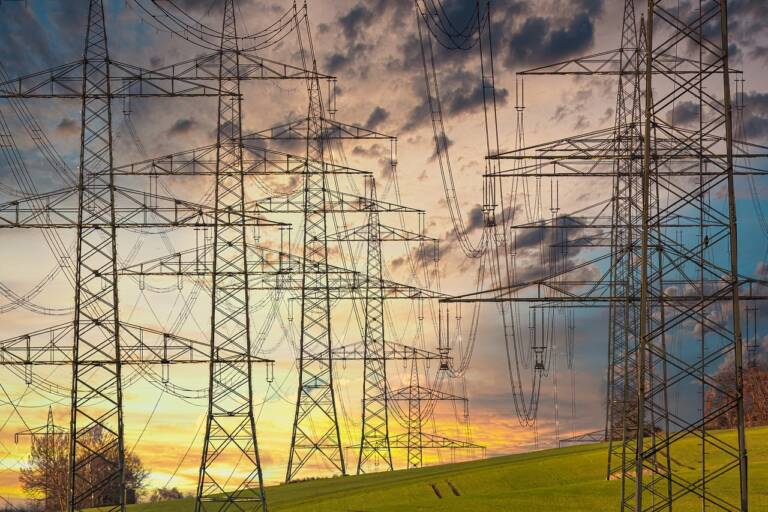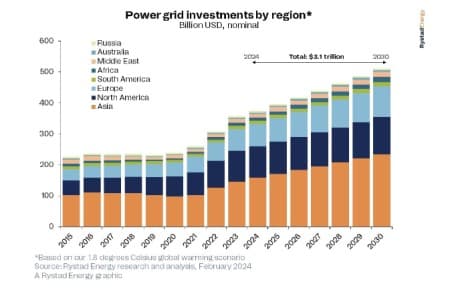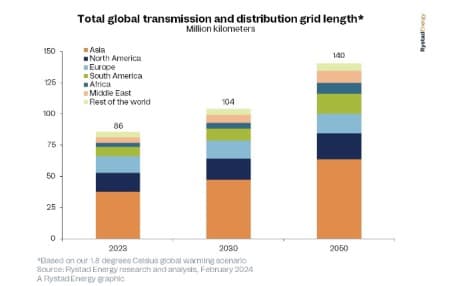$3.1 trillion in investments in energy networks are needed to contain global warming

Renewable energy development continues apace, with $644 billion to be spent on new capacity in 2024, but aging and inadequate electricity grids could prove a significant obstacle to the energy transition. According to research by Rystad Energy, $3.1 trillion in investments in grid infrastructure is needed before 2030 if global warming is to be limited to 1.8 degrees Celsius above pre-industrial levels.
In this scenario, an additional 18 million miles of grid would be needed to keep pace with ongoing electrification in cities and counties, including new renewable energy capacity and the rapid adoption of electric vehicles. In this way, the total length of all the world's electricity grids would reach 104 million kilometers in 2030 and expand to 140 million kilometers in 2050, almost the same distance between the Earth and the Sun. The immediate expansion of 18 million kilometers would require almost 30 million tons of copper, a commodity that is already in short supply.
The growth in global demand for electricity is the main factor determining the need to upgrade networks. This increase is due to population expansion, industrialization and urbanization in developing countries, and efforts to mitigate climate change through electrification. Cybersecurity, geopolitics, and the growing priority of ensuring a reliable national energy supply also contribute to this need. However, an inefficient regulatory framework could significantly delay the development of networks and, consequently, the energy transition.
“Electricity networks will be both a support factor and an obstacle to the energy transition. Mature networks have enabled the rapid expansion of solar and wind capacity in recent years, but many national grids are now at or near the point where no further connections can be made without upgrading or expanding them. Annual investment levels must increase if the current trend of renewable energy expansion is to continue,” says Edvard Christoffersen, senior analyst at Rystad Energy.
The current network of 86 million km of networks is insufficient
The combined length of all transmission and distribution networks globally is approximately 86 million kilometers, a distance enough to encircle the planet more than 2,100 times. The transmission network includes 6 million kilometers of high-voltage lines (over 70 kilovolts [kV]). In comparison, the much larger distribution network is made up of approximately 8 million kilometers of medium voltage lines (10 to 70 kV) and a colossal network of low voltage lines (less than 10 kV) spanning it extends for approximately 72 million kilometres, reaching homes in every corner of the world. The length of the network is set to increase to 104 million kilometers by 2030 and 140 million kilometers by 2050. Asia is set to contribute more than half of the global additions this decade, with China and India leading the way as the world's first and third largest energy consumer.
Rystad expects investment in global networks to reach $374 billion this year, with China accounting for about 30% of the total. Asia will lead the way in grid expansion investments, but other regions are playing catch-up to keep pace with renewable capacity additions. The US Infrastructure Investment and Jobs Act (IIJA) provides $65 billion to upgrade and expand national electricity infrastructure, while the European Commission launched a Grid Action Plan in late November 2023, calling for €584 billion ($626 billion) in investments between 2020 and 2030. The Commission and the European Investment Bank (EIB) are also evaluating how to optimize financing to support these important investments in networks. In the UK, National Grid has launched an action plan to revamp its network for the first time in decades, investing more than £16 billion ($20.16 billion) in upgrades between 2022 and 2026.
The rapid expansion of the electricity grid will require large volumes of raw materials, especially copper and aluminum . Copper is mainly used as a conductor in underground distribution, transmission and submarine cables, while overhead lines use aluminium. Although aluminum is predominantly used in overhead lines, it can be substituted as a conductor in underground lines. Demand for copper and aluminum is expected to increase nearly 40% by the end of the decade, but networks are not the primary driver. Copper and aluminum are also critical to myriad other applications in the construction, transportation, renewable energy and consumer products industries. Networks account for only about 14% of global copper demand, or about 4 million tonnes in 2024.
Alternatives to network construction
Grid extension is necessary to support intermittent and remote renewable energy production and to connect new industrial, commercial and residential areas, but alternatives also exist to meet growing energy demand . Deploying large-scale battery storage can solve the intermittency problems associated with renewables and enable higher average grid loads, reducing the need for new lines. Overhauls and upgrades to the existing network can increase capacity per kilometre, and digitalisation can free up capacity by addressing flexibility issues. At the same time, distributed energy sources such as rooftop solar can reduce the need for new lines. It is clear that the current global grid infrastructure is not capable of meeting the needs of the future energy system.
Tortuous permitting processes are already causing bottlenecks in many countries, including the United States and the United Kingdom. The adoption of large-scale battery storage solutions and grid digitalization can solve some problems related to grid intensity, but the electrification of society will require greater attention and efforts to streamline regulatory frameworks and encourage investments in a way that networks can be an improvement factor rather than an inhibitor of the energy transition.

Thanks to our Telegram channel you can stay updated on the publication of new Economic Scenarios articles.
The article $3.1 trillion in investments in energy networks is needed to contain global warming comes from Economic Scenarios .
This is a machine translation of a post published on Scenari Economici at the URL https://scenarieconomici.it/sono-necessari-3100-miliardi-di-usd-in-investimenti-nelle-reti-energetiche-per-contenere-il-riscaldamento-globale/ on Sun, 18 Feb 2024 06:15:05 +0000.


